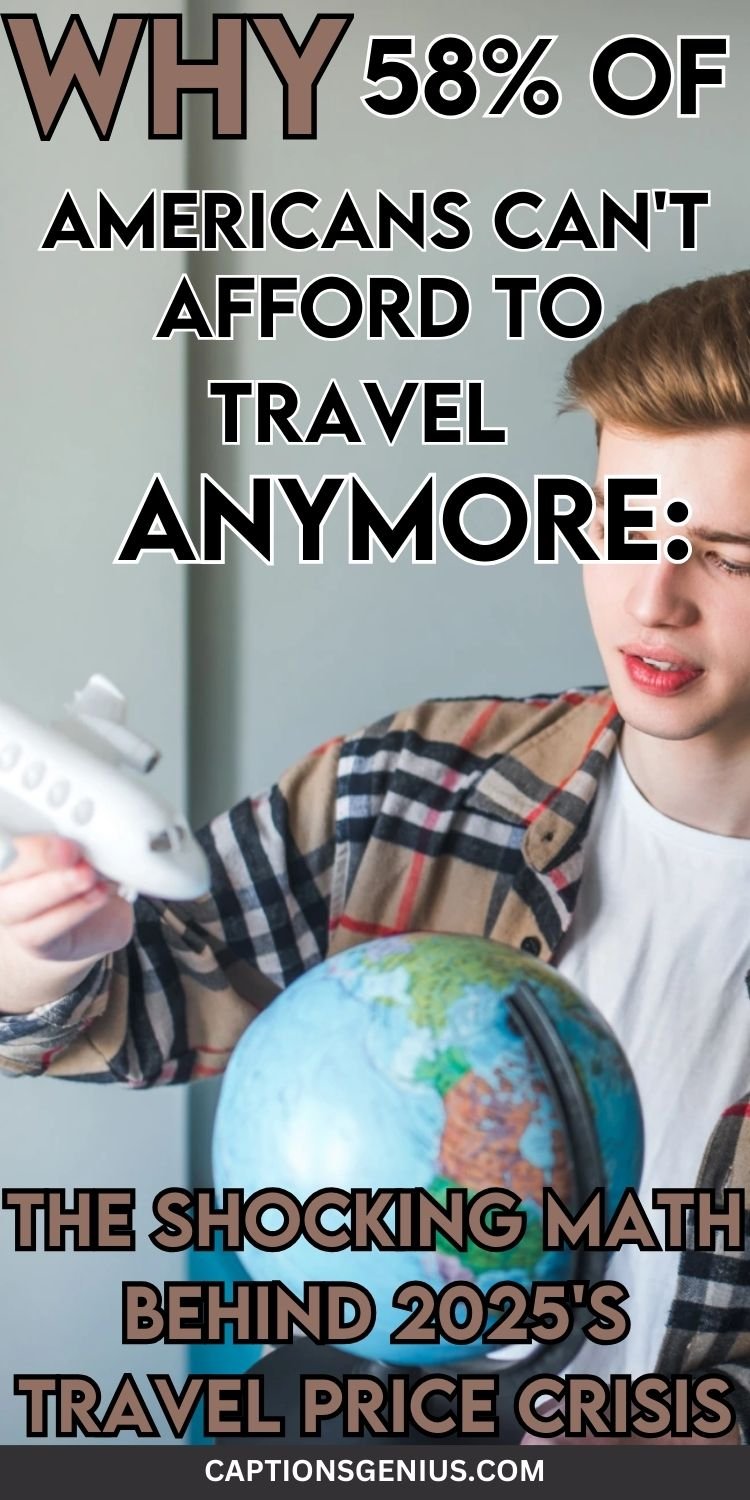Despite earning six figures combined, Sarah and Mike from Maine had to go into debt to take their daughter to a cheerleading competition in Florida, and they’re not alone. Only 46% of Americans plan to travel this summer, with 65% of non-travelers citing cost as the barrier.
The average travel budget doubled from $5,300 in 2024 to $10,244 in 2025, while summer trips now average $3,861 per family. 29% of travelers plan to go into debt for vacations, with 26% already having taken on vacation debt and 13% raiding retirement savings.
Hotel prices remain 15% above pre-pandemic levels, and vacation costs increased $1,400 year-over-year while wages stagnated. Your family’s financial strain from travel isn’t unusual; it’s the new normal for middle-class America, where even six-figure households struggle to afford routine family experiences.
Why 58% of Americans Can’t Afford to Travel Anymore: The Shocking Math Behind 2025’s Travel Price Crisis

The Shocking Statistics: How Many Americans Really Can’t Afford Travel

The travel affordability crisis hits 150 million Americans. IPX1031 research shows 58% of Americans want to travel more but can’t afford it. Allianz Partners found an alarming contradiction: 51% admit they can’t afford a vacation, yet 39% will travel anyway. Families are choosing debt over staying home.
The Participation Drop-Off

Americans can’t afford travel at record levels. Bankrate data shows that only 46% are planning summer vacations in 2025. Among non-travelers, 65% cite affordability, and 64% say travel is too expensive. Basic family getaways now require luxury budgets.
The Debt Crisis Behind Vacations

Vacation debt statistics reveal the depth. 29% of Americans plan to borrow for travel, averaging $2,849 per household. 27% need over a year to repay vacation debt. The travel affordability crisis forces families to finance what was once a standard middle-class benefit.
The Real Cost of Travel: Breaking Down 2025’s Price Explosion

Hotel price increases have devastated family budgets. Rates jumped 1.7% year-over-year and sit 15% above pre-pandemic levels. Vacation costs in 2025 reflect this brutal reality: the average family now spends $3,600 for just three days.
The Long-Term Inflation Reality
LISEP data shows travel expenses exploded 170% from 2001-2023. Travel price inflation 2025 continues this trend with average travel budgets hitting $10,244; nearly double 2024’s $5,300.
When Basic Trips Become Luxury

A two-day Disney World trip now exceeds the bottom 20% of households’ entire annual travel budget. What middle-class families once considered normal getaways require upper-class incomes.
Why Middle-Class Families Are Hit the Hardest

Middle-class travel affordability crumbles when you examine the numbers. National middle-class income ranges from $41,392 to $124,176, yet middle-class vacation costs now demand luxury budgets. Even families earning $100K+ struggle with travel expenses.
The Spending Power Squeeze
Gallup reports 55% of Americans rate their financial situation as fair or poor. LISEP data reveals real spending power decreased 4% on average, while travel costs skyrocketed. The travel costs vs income gap widens yearly.
Living Costs vs. Vacation Dreams

Middle-class families face impossible choices: necessities consume larger income portions, leaving less for discretionary spending. Travel has shifted from middle-class expectation to upper-class privilege.
The Psychology of “Justi-vacationers”: Why People Travel Despite Being Broke

“Justi-vacationers” travel despite financial stress, justifying expenses they can’t afford. 39% of Americans who can’t afford a vacation will travel anyway, creating widespread vacation debt.
The Desperation Factor

72% report being “desperate” for a vacation, revealing the emotional need for travel. Mental health concerns drive families to prioritize temporary escape over financial stability.
Social Pressure and Payment Methods

25% of Gen Z feel pressured by friends to take unaffordable trips. 85% use credit cards for travel expenses, fueling the debt cycle that transforms vacations into long-term financial burdens.
Regional Breakdown: Where Travel Is Most and Least Affordable
Travel cost by state varies dramatically with local income levels. Massachusetts middle-class earns $66,565-$199,716, while the Mississippi middle-class ranges $36,132-$108,406. Detroit sets the lowest threshold at $25,384 for middle-class entry.
The Geographic Travel Squeeze
Regional travel costs create unequal vacation access. High-income states face expensive local destinations, while low-income areas offer fewer nearby options. Middle-class families in expensive states often can’t afford vacations in their own regions.
International vs. Domestic Pricing
International travel dropped 4% in cost while domestic prices surged. Affordable travel destinations increasingly lie overseas rather than within U.S. borders. Asia-Pacific regions offer 11% lower hotel rates, making foreign trips more economical than domestic alternatives.
Smart Solutions: How to Travel on a Tight Budget in 2025
Budget travel tips 2025 show 82% use cost-saving strategies, 45% choose budget destinations, and 32% travel off-season for savings. 30% opt for staycations instead of distant travel.
Maximizing Rewards and Technology

Travel rewards maximization drives results: 58% use points/rewards to cover expenses. 52% use AI tools for deal hunting. Alternative airports and flexible dates unlock hidden savings.
Smart Accommodation and Transportation
Affordable vacation strategies focus on lodging alternatives and transportation hacks. Budget accommodations, shared rentals, and strategic flight booking reduce costs significantly. These methods help families travel without destroying finances, though they require more planning and flexibility than traditional vacation booking.
Conclusion
The data confirms what millions of families already know: Americans can’t afford travel in 2025. With only 46% planning summer trips and 65% citing cost barriers, the middle-class squeeze between stagnant wages and soaring vacation costs has reached a breaking point.
Smart strategies like off-season travel and rewards maximization offer some relief. Yet these workarounds can’t solve the fundamental problem: travel has shifted from middle-class expectation to luxury privilege, with average budgets doubling to $10,244 annually.
With 29% of travelers going into debt and hotel prices 15% above pre-pandemic levels, families must choose between financial responsibility and vacation dreams. Strategic planning becomes essential for any family travel.

